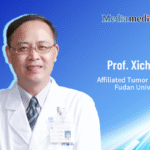
Editor’s Note: Anti-HER2 therapy has long been the cornerstone of treatment for patients with HER2-high (IHC 3+ or IHC 2+/FISH+) advanced gastric cancer. In recent years, combining anti-HER2 therapy with immunotherapy in the first-line setting has further improved patient outcomes, while the emergence of novel HER2-targeting antibody-drug conjugates (ADCs) has expanded options in later-line settings. However, a gap remains in second-line anti-HER2 therapy. At the gastric cancer session of the 2025 BOC/BOA meeting, Professor Zhi Peng from Peking University Cancer Hospital presented the latest research results from the recent ASCO Annual Meeting. In an exclusive interview with Oncology Frontier, he discussed the current landscape of advanced gastric cancer treatment and how new drugs like HER2 ADCs may close existing therapeutic gaps and transform clinical practice.01
Oncology Frontier: Chemotherapy, immunotherapy, and anti-HER2 regimens have formed the backbone of first-line treatment for advanced gastric cancer. However, what unmet clinical needs remain in second- and later-line treatment for patients who fail first-line therapy?
Prof. Zhi Peng: In recent years, targeted therapy, immune checkpoint inhibitors (ICIs), and ADCs have reshaped the treatment landscape for advanced gastric cancer. The updated CSCO guidelines now stratify treatment based on HER2 expression: high, intermediate, low, or negative.
In first-line treatment, anti-HER2 therapy combined with immunotherapy has become the standard for HER2-high tumors. For HER2-intermediate/low/negative tumors, treatment typically involves chemotherapy alone or in combination with immunotherapy or targeted therapy, depending on PD-L1 or Claudin18.2 expression. In the second-line setting, regardless of HER2 status, standard therapy remains paclitaxel combined with VEGFR-targeted agents or chemotherapy alone; patients with dMMR/MSI-H tumors may be eligible for immunotherapy. In third-line treatment, T-DXd and RC48 are preferred for HER2-high patients. RC48 is also an option for HER2-intermediate patients, while those with HER2-low/negative tumors mainly receive VEGFR-targeted monotherapy or immunotherapy.
This clearly shows that there is currently no established anti-HER2 therapy in the second-line setting for advanced gastric cancer.
Additionally, while large Phase III trials have shown consistent PFS improvements for second-line paclitaxel plus VEGFR-targeted therapy (irrespective of HER2 status), overall survival (OS) benefits have varied. Notably, in HER2-positive patients, continuing trastuzumab beyond progression has failed to improve PFS, OS, or objective response rate (ORR). Thus, there is an urgent need for new second-line regimens that can address these unmet needs—particularly to fill the void in second-line anti-HER2 options.
02
Oncology Frontier: At this year’s BOC/BOA, you presented the DESTINY-Gastric-04 (DG-04) study on a novel HER2-targeted ADC for second-line therapy, recently reported at ASCO. How do you evaluate its findings and potential clinical impact?
Prof. Zhi Peng: T-DXd is a next-generation HER2-targeted ADC with several pharmacological advantages, including a high drug-to-antibody ratio, bystander effect, and high plasma stability. These features result in high efficacy with manageable toxicity and have led to breakthroughs across several solid tumor types.
In advanced gastric cancer, the earlier DG-01 and DG-06 studies already changed clinical practice by establishing T-DXd as the standard third-line therapy for HER2-high patients. The Phase II DG-02 study in Western countries suggested that T-DXd also had strong potential as a second-line option, sparking high expectations about its ability to reshape the treatment paradigm.
DG-04 is a global, multicenter, randomized Phase III study that enrolled 494 patients with HER2-positive (IHC 3+ or IHC 2+/ISH+) advanced gastric or gastroesophageal junction adenocarcinoma who had progressed after trastuzumab-based therapy. Patients were randomized 1:1 to receive either T-DXd or ramucirumab plus paclitaxel (RAM + PTX). Notably, nearly 20% of enrolled patients came from China or neighboring regions (49 patients in each group).
Interim analysis presented at ASCO showed that the study met its primary endpoint. Median OS in the T-DXd group was 14.7 months—an improvement of 3.3 months over RAM + PTX (14.7 vs. 11.4 months), with a 30% reduction in risk of death (HR 0.70, 95% CI: 0.55–0.90, P = 0.0044). Importantly, 25.8% of patients in the RAM + PTX group later received HER2 ADCs, including 21.0% who received T-DXd. After adjusting for the effect of subsequent therapy, the OS benefit of T-DXd increased, with a 36% reduction in death risk (HR 0.64, 95% CI: 0.44–0.93).
Secondary endpoints further confirmed the benefit of T-DXd:
- Median PFS: 6.7 vs. 5.6 months (HR 0.74, 95% CI: 0.59–0.92, P = 0.0074)
- ORR: 44.3% vs. 29.1% (+15.2%, P = 0.0006)
- Disease control rate (DCR): 91.9% vs. 75.9% (+16%)
- Median duration of response (DoR): 7.4 vs. 5.3 months (+2.1 months)
T-DXd also showed a favorable safety profile. Grade ≥3 treatment-emergent adverse events (TEAEs) occurred in 68.0% of patients in the T-DXd group, lower than 73.8% in the RAM + PTX group. Serious TEAEs occurred in 41.0% vs. 43.3%. TEAEs leading to drug discontinuation, dose interruption, or dose reduction were also less frequent in the T-DXd group. The safety profile of T-DXd was consistent with previous reports, with hematologic toxicities such as neutropenia, anemia, and leukopenia being the most common—comparable to or lower than those seen with RAM + PTX.
In summary, T-DXd significantly improved survival and treatment efficacy compared to the current second-line standard, with excellent tolerability. Given the current absence of an anti-HER2 regimen in the second-line setting—where anti-VEGFR plus chemotherapy remains standard—DG-04 marks a critical breakthrough that fills this therapeutic gap.
03
Oncology Frontier: Looking ahead, what are the key directions for future research on HER2 ADCs, and how might they further change clinical practice?
Prof. Zhi Peng: Novel HER2 ADCs are transforming the treatment landscape for advanced gastric cancer and may move further into earlier lines of therapy. In first-line treatment, the KEYNOTE-811 regimen (pembrolizumab + trastuzumab + FP or CAPOX) is already widely used. The next question is: can HER2 ADC-based combinations redefine the standard of care in the first-line setting?
Ongoing trials such as DG-05 (T-DXd ± pembrolizumab + fluoropyrimidine or capecitabine) and HERIZON-GEA-01 (Zanidatamab ± tislelizumab + chemotherapy) are exploring this question. Several HER2 ADCs are also accelerating toward frontline approval both in China and internationally. We hope to see positive results from these trials that could lead to changes in standard practice.
In parallel, new developments in ADCs, targeted therapies, and immunotherapies continue to emerge—especially bispecific antibodies. For instance, the ARTEMIDE-Gastric01 study is evaluating T-DXd combined with fluoropyrimidine and Rilvegostomig, a PD-1/TIGIT bispecific antibody, in HER2-high and PD-L1 CPS ≥1 patients in the first-line setting. This could offer a new precision medicine strategy for gastric cancer.
Beyond HER2, additional targets are being explored—including Claudin18.2, MET, EGFR, and FGFR2. For example, bemarituzumab (a FGFR2b inhibitor) combined with mFOLFOX6 recently reached its primary endpoint in the Phase III FORTITUDE-101 trial for frontline gastric cancer. As more targetable biomarkers are identified, an important question arises: how should we choose precision therapy for patients expressing multiple targets? This will be a key area for future exploration.


About Professor Zhi Peng
- MD, PhD; Doctoral Supervisor
- Chief Physician, Peking University Cancer Hospital
- Peking University Boya Young Scholar
- National-Level Young Talents Program Awardee
- Member, Gastric Cancer Committee, Chinese Anti-Cancer Association (CACA)
- Member, Tumor Metastasis Committee, CACA
- Member, Precision Oncology Committee, CACA
- Member and Secretary, Gastric Cancer Expert Committee, CSCO
- Member, Oncology Nutrition Therapy Committee, CSCO
- Member, Clinical Immunology Committee, Chinese Society for Immunology
- Vice Chair, Precision Therapy Committee for GI Tumors, Beijing Anti-Cancer Association
- Secretary-General, Gastric Cancer Committee, Beijing Anti-Cancer Association
- Editorial Board Member, Chinese Medical Journal and Journal of Integrated Cancer Therapy
- Recipient of the Chinese Medical Association First Prize, CACA Young Scientist Award, and CACA First Prize


